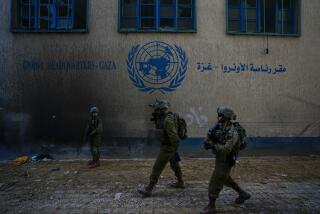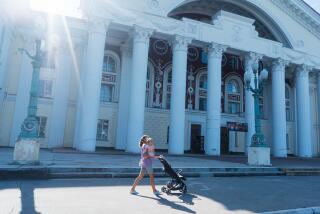Cold War-era chills. Tourists welcome.
- Share via
MOSCOW — Deep underground in a Cold War-era nuclear bomb shelter, guide Alexei Alexandrov did his best to set a spooky mood, starting with his 1960s Soviet army uniform.
“Please don’t split away from the group,” he somberly warned visitors to the labyrinth of tunnels shaped into cavernous rooms and lengthy hallways, “or you may get lost in the dark and end up shot by a guard by mistake.”
At the budding Moscow tourist attraction called the Confrontation Cold War Museum, historical remembrance and a touch of make-believe mix in an ambiguous but thought-provoking cocktail.
With Washington and Moscow recently trading harsh rhetoric and some analysts warning of a possible slide back toward Cold War attitudes, the shelter serves as a reminder of what that period was like -- and of the fact that similar facilities still function in both countries despite the disappearance of old fears.
The still-unfinished museum doesn’t exactly preach. But it aims to send a message. A sign in the entryway declares: “It’s important which questions a person asks himself after visiting the complex, which fears worry him, and what he’s pondering.”
Also known as the Tagansky Underground Command Center, the 75,000-square-foot facility was built 200 feet below ground level as a communications complex meant to survive a U.S. nuclear attack on Moscow. Work on it began in 1952, when Stalin was still Soviet dictator, and it went into service four years later.
The site was in operation through the 1970s, with a staff of 2,500, of whom 1,500 could be on duty at any one time. In the event of a nuclear war, it would have been sealed, with enough stored food for three months, and systems to purify the air. A planned 1980s renovation was abandoned as tensions between the Soviet Union and the West eased, and the site was declassified in 1995.
Now the whole thing has been bought by a private firm, which is converting it to a museum and entertainment complex that mixes advocacy of world peace with displays of Russian patriotism, and what sometimes seems like a touch of nostalgia for Soviet power.
The addition of more displays to enhance the atmosphere is planned. But the mostly empty rooms and hallways, with some half-century-old communications equipment and a variety of Soviet-era posters, themselves evoke a chill. The wall posters include one that is almost touching in its naivete, labeled “Actions of a Soldier During the Flash of a Nuclear Explosion.” It shows the mushroom cloud of a nuclear blast, one soldier hiding behind a tree stump and others in trenches.
During the tour, Alexandrov painted a picture of a virulently anti-communist 1950s America that had demonstrated, in Hiroshima and Nagasaki, Japan, that it was “ready to use nuclear weapons against civilian populations.”
“They didn’t want to talk to us at the time. Instead, they were quite willing to ‘destroy the hydra of communism in its lair,’ ” he told the group of university students and young businesspeople. “It was life under gun sights. The threat was so imminent that our leadership could only have three or four minutes to make a decision.”
Visitors were encouraged to wear olive-green Soviet army ponchos for the tour, and Alexandrov demonstrated the use of a gas mask and a 1960s Geiger counter still in working condition.
White respiratory face masks were handed out as part of the atmospherics, and some wore them while posing for souvenir snapshots. Each visitor was given a bright red USSR Defense Ministry pass with their name and a mug shot of someone wearing a gas mask. The tour also included a Cold War-era military rations meal consisting of buckwheat porridge with canned stewed beef and a shot of vodka.
Andrei Kvyk, 21, a student at the Moscow Construction Institute, said being in the shelter gave him “the creeps.”
“They say that this is all a thing of the past and that the Cold War is over,” he said. “But I don’t think that’s the case. I am sure facilities like this still exist in Moscow and across the country and are on combat duty every second. I am sure the Cold War was never over. They are lying to us.”
The complex was constructed with techniques similar to that used to drill subway tunnels, and walking through it feels like a journey through huge pipes. The largest rooms, built in 30-foot-diameter tunnels, have arched ceilings. The old floors have been ripped out, and in many places one walks on a mix of soil and debris. In a few spots, water drips ominously.
The complex has tunnels linking it to the Moscow subway, which is even older, and in certain areas the roar of trains can be clearly heard.
“It is so spooky -- these tunnels, this porridge, this damp air 60 meters under the ground,” said Yana Arutyunova, 25, a market researcher who joined the tour. “People in the tunnels look like ghosts of the past. You can’t but feel danger here. Everything was removed at some point, all the equipment, but you can still feel this concentrated cold fear permeating the air.”
The complex is mostly empty, but there is a theater that shows a documentary about the Cold War, and souvenir stands are being installed. Ticket prices are $9.75 for students, $19.50 for adults and $39 for foreigners who take an English-language tour. Visits are allowed only by advance arrangement.
Plans call for construction in the complex of a replica of a central combat management facility, said Olga Arkharova, the museum’s director. A military-themed restaurant also is planned.
“The task of our complex, which is called Confrontation, is to preserve this facility as a reminder and a warning that situations like this should be prevented forever,” Arkharova said. “The idea we want to present to the children and the adults is that we want to have an open and frank dialogue with other countries, to prevent the world from entering another situation where we’re forced to build facilities like this.”
Arkharova’s explanation fits with a sympathetic interpretation of Russian President Vladimir V. Putin’s recent behavior. He has alternated between harsh complaints about Bush administration policies and apparent efforts to promote cooperation, all while his aides say he is aiming for a dialogue that recognizes Russia’s national interests.
In recent months, Putin has fiercely criticized U.S. plans to install missile defenses in Eastern Europe. Washington says the system is meant to counter missiles that Iran may develop, but Moscow expresses fear that it is part of a long-term effort to undercut Russia’s nuclear deterrent.
At the Group of 8 summit of leading industrialized nations early this month in Germany, Putin suddenly changed tack, suggesting that Russia and the U.S. cooperate in an antimissile system making use of a large radar system in the former Soviet republic of Azerbaijan. The proposal appeared to puncture, at least for now, talk of a rapid deterioration in relations.
While playing up the chilling nature of the Confrontation museum, its operators do not make it precisely clear just how the facility was used.
Arkharova said that it was mainly built to house the civilian Communications Ministry in case of nuclear war, and that it included a backup central post office. Literature in English for tourists describes it as having been built “for providing operational safety of the command post of one of the armed forces divisions.”
Alexandrov, the tour guide, said that in the event of war, Moscow’s antiaircraft headquarters would have been located here.
The entrance is in a nondescript building, behind a green gate now decorated with a large red star.
“In the 1950s and 1960s, none of the people who lived in this area even guessed what was under their feet,” Arkharova said. “The site was designed to ensure the necessary communications to run the country during time of war. It can protect from a nuclear strike.”
Alexandrov painted a picture of high tension for employees.
“Every time, when people who worked here were saying goodbye to their relatives before going on duty, they thought that they were seeing their family for the last time,” he said. “So tense and dramatic the situation was. So troubled the atmosphere.”
Nina Borodina, 21, a university student, said that “these haunting shafts” made her think of how her grandmother “lived all her life feeling the danger of being bombed any second.”
“She told me how terrified they were of an imminent nuclear war back in the 1960s,” Borodina said. “Now I can understand a little of what she lived through. I don’t think there is any danger of nuclear war now. We are friends with the West.”
She said she was convinced that, whatever complaints the two sides may voice about each other, Putin “is leading the country along the way of real cooperation with the United States and other Western countries, and they will never be our enemies again.”
“But it was good to come down here,” she added. “It gives you a sense of what horrors we were saved from.”
--
Times staff writer Sergei L. Loiko contributed to this report.
More to Read
Sign up for The Wild
We’ll help you find the best places to hike, bike and run, as well as the perfect silent spots for meditation and yoga.
You may occasionally receive promotional content from the Los Angeles Times.






